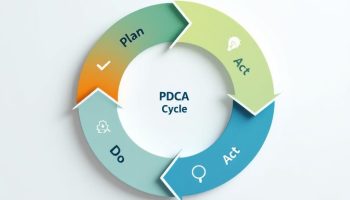
Kaizen in Practice
Kaizen in practice transforms organizations through its Japanese management philosophy focused on continuous, incremental improvement with full employee participation. This approach values each small daily adjustment as part of a larger transformation, making improvement an essential business operation rather than a separate activity.
Key Takeaways:
- Kaizen focuses on small, persistent improvements rather than seeking immediate perfection
- Employee empowerment is crucial for successful implementation
- The methodology thrives on identifying and eliminating non-value-adding activities
- Data-driven decision making guides improvement efforts
- Continuous improvement becomes part of the organizational culture, not a temporary initiative
The power of kaizen lies in its simplicity. Organizations implement this lean methodology by encouraging staff at every level to spot and fix inefficiencies. You’ll find its impact most significant when small changes accumulate over time, creating substantial operational enhancements.
Employee involvement forms the foundation of effective kaizen practices. Staff members directly performing tasks often have the clearest insights into potential improvements. Their participation leads to more practical solutions and increases buy-in for changes.
Kaizen’s systematic approach to eliminating waste helps companies identify activities that don’t add value. Through regular kaizen events, teams can target specific processes for rapid improvement, often yielding immediate efficiency gains.
Data drives successful kaizen implementation. Measuring current performance establishes baselines and helps track progress. This quantitative approach ensures changes actually improve operations rather than just altering them.
The ultimate goal extends beyond individual improvements. Kaizen builds a culture where everyone constantly questions current methods and suggests better alternatives. This mindset shift makes continuous improvement part of your company’s DNA, creating lasting competitive advantages.
“Kaizen transforms organizations by turning small, daily improvements into a powerful culture of continuous growth, where every employee is empowered to eliminate inefficiencies and drive change. In this philosophy, it’s not about achieving perfection overnight, but rather embracing incremental progress that shapes lasting success.”
Origin and Philosophy
Kaizen in practice represents a Japanese management principle meaning “good change.” This comprehensive strategy drives incremental, continuous organizational improvement by engaging employees across all levels. The philosophy emphasizes that every small daily adjustment contributes to significant long-term transformation in your business operations.
The essence of kaizen in practice lies in its holistic approach. You’ll find that successful implementation requires commitment to the belief that continuous improvement should be part of daily work routines. Kaizen in practice doesn’t seek perfection immediately but values steady progress through persistent effort. Your team members become active participants in identifying inefficiencies and suggesting practical solutions.
Foundational Elements of Kaizen
The kaizen in practice methodology rests on several key foundations that you can implement in your organization:
- Employee empowerment: Kaizen in practice thrives when staff at all levels feel encouraged to identify problems and propose solutions
- Process orientation: Focus on improving how work happens rather than simply measuring end results
- Elimination of waste: Identify and remove activities that don’t add value
- Data-driven decision making: Use metrics to guide improvement efforts
- Standardization: Document best practices to create consistency
Continuous improvement through kaizen in practice creates a culture where change is welcomed rather than feared. When implementing kaizen in practice, you’ll need to establish systems that make improvement part of your operational DNA.
| Traditional Approach | Kaizen in Practice Approach |
|---|---|
| Problem-hiding | Problem-highlighting |
| Blame-focused | Solution-focused |
| Management-driven | Everyone-driven |
| Periodic big changes | Daily small improvements |
| Reactive | Proactive |
This philosophy has proven effective across various industries because kaizen in practice adapts to different organizational contexts. Your project leadership approach will benefit from incorporating kaizen principles, as they encourage transparency and collaborative problem-solving.
The kaizen in practice methodology doesn’t require substantial investment to begin implementation. You can start with simple observation techniques like “gemba walks” (going to the actual workplace) to identify improvement opportunities. Through these walks, managers gain firsthand knowledge of processes rather than relying solely on reports.

Core Principles of Continuous Improvement
The fundamental strength of kaizen in practice lies in its employee-centered approach to change. You’ll achieve more sustainable improvements when frontline staff actively participate in identifying problems and suggesting solutions. This collaborative process creates a sense of ownership that drives continuous improvement forward.
Kaizen in practice focuses on enhancing processes rather than rigid goal-setting. By examining how work gets done rather than just what results are achieved, you’ll uncover opportunities for efficiency that might otherwise remain hidden. This approach acknowledges that perfection is a journey, not a destination.
Creating a transparent, blame-free environment is essential for effective kaizen implementation. You can’t improve what people are afraid to discuss. When employees know they won’t face punishment for highlighting issues, they become powerful agents of positive change. This psychological safety is the foundation upon which kaizen in practice thrives.
Systematic waste reduction forms another critical principle of kaizen in practice. This includes eliminating the eight common wastes: defects, overproduction, waiting, non-utilized talent, transportation, inventory, motion, and extra-processing. By targeting these inefficiencies, you’ll optimize resource utilization across your organization.
Employee Engagement Strategies
To maximize kaizen in practice, consider these proven engagement methods:
- Daily huddles where teams can discuss improvement ideas
- Suggestion systems that track, evaluate and implement employee recommendations
- Cross-functional improvement teams that break down departmental silos
- Recognition programs that celebrate successful kaizen initiatives
- Visual management boards that make progress visible to everyone
When implementing continuous improvement through kaizen, consistent communication is vital. Regular team meetings create forums where kaizen in practice becomes tangible through shared insights and collaborative problem-solving.
The following table illustrates how different levels of the organization contribute to kaizen in practice:
| Organizational Level | Kaizen Role | Key Activities |
|---|---|---|
| Executives | Strategic direction | Set improvement priorities, allocate resources |
| Middle Management | Implementation support | Coach teams, remove barriers, align initiatives |
| Frontline Staff | Hands-on improvement | Identify issues, test solutions, standardize improvements |
| Support Functions | Facilitation | Train teams, track progress, share best practices |
Developing a kaizen mindset requires patience and effective leadership. You’ll need to demonstrate that small improvements are valued just as much as major breakthroughs. When kaizen in practice becomes part of your company’s DNA, continuous improvement becomes second nature rather than an additional task.

Implementing Kaizen Methodology
Putting kaizen in practice requires a structured approach that empowers every team member to contribute to positive change. The Plan-Do-Check-Act (PDCA) cycle forms the backbone of kaizen implementation, creating a systematic framework for continuous improvement initiatives. You’ll find this cycle helps your team test solutions on a small scale before full implementation, minimizing risk while maximizing learning opportunities.
Cross-functional teams drive kaizen success by bringing diverse perspectives to problem-solving efforts. These teams work together to identify inefficiencies, propose solutions, and implement changes that boost productivity across departments. Kaizen in practice thrives when you break down traditional silos and encourage collaboration between team members with different expertise.
Kaizen Events and Standardization
Focused kaizen events (also called kaizen blitzes) offer concentrated improvement opportunities. These structured 3-5 day workshops tackle specific process challenges with dedicated teams. During these events, participants:
- Analyze current processes through direct observation
- Identify waste and non-value-adding activities
- Develop and test immediate improvements
- Document standardized work procedures
- Establish metrics to measure progress
Standardized work documentation serves as the foundation for kaizen in practice. You can’t improve what you haven’t standardized first. By clearly documenting current best practices, you create a baseline for ongoing refinement. This documentation should be:
- Visual and easily understood
- Accessible to all team members
- Regularly updated to reflect improvements
- Used for training and knowledge transfer
The following table shows how kaizen in practice differs from traditional improvement approaches:
| Aspect | Traditional Approach | Kaizen in Practice |
|---|---|---|
| Focus | Results-oriented | Process-oriented |
| Changes | Large, infrequent | Small, continuous |
| Leadership | Top-down directives | Employee engagement at all levels |
| Investment | High-cost solutions | Low/no-cost improvements first |
| Timeline | Project-based, fixed | Ongoing, perpetual |
Successful continuous improvement through kaizen requires commitment to both the philosophy and methodology. You’ll see the most significant impact when kaizen in practice becomes embedded in your organizational culture rather than treated as a temporary initiative. By engaging employees in regular project collaboration, you create an environment where improvement becomes a natural part of daily work.

Strategic Tools and Techniques
Implementing kaizen in practice requires specific tools that support continuous improvement efforts. You’ll need these strategic approaches to drive meaningful change throughout your organization. Kaizen in practice transforms daily operations through structured methodologies that engage your entire team.
Essential Kaizen Implementation Tools
The 5S system forms the foundation of workplace organization in kaizen in practice. This methodology optimizes your workspace through five sequential steps:
- Sort: Remove unnecessary items from the work area
- Set in order: Arrange tools and materials for maximum efficiency
- Shine: Clean and inspect the workspace regularly
- Standardize: Create consistent procedures for the first three steps
- Sustain: Maintain discipline through regular audits and improvements
Gemba walks represent another crucial technique in kaizen in practice. By directly observing operations where value creation happens, you gain firsthand insights impossible to obtain from reports alone. These structured workplace visits help you identify improvement opportunities that might otherwise remain hidden.
Cross-functional collaboration mechanisms break down departmental silos that often impede continuous improvement. When implementing continuous improvement initiatives, teams with diverse expertise can solve complex problems more effectively than homogeneous groups working in isolation.
Data analytics integration has revolutionized kaizen in practice by providing objective measurement of process performance. Modern kaizen implementations leverage machine learning to identify patterns and optimization opportunities that human observation might miss. This data-driven approach to kaizen in practice ensures your improvement efforts target the most impactful areas.
Zero investment improvement strategies demonstrate the true spirit of kaizen in practice – finding creative solutions with existing resources. These approaches focus on process refinement rather than capital expenditure, making kaizen in practice accessible even with limited budgets. By optimizing processes without significant financial outlay, you’ll create a culture where innovation thrives regardless of resource constraints.
Visual management tools make problems immediately visible in kaizen in practice. Status boards, performance charts, and process indicators create transparency that drives accountability and continuous improvement. This visibility ensures everyone understands current performance and improvement priorities.

Measurable Business Impact
When implemented effectively, kaizen in practice delivers significant and quantifiable business improvements. You’ll find that these improvements extend beyond theoretical benefits to concrete financial and operational gains. Kaizen in practice transforms small, incremental changes into substantial long-term value.
Organizations applying kaizen in practice consistently report measurable cost reductions and efficiency improvements. Manufacturing companies have achieved approximately 0.5% fixed cost reduction through systematic waste elimination and process optimization. This seemingly small percentage often translates to millions in savings for large operations.
In service sectors, kaizen implementation has driven revenue increases averaging 5%, primarily through enhanced customer satisfaction and streamlined service delivery. These improvements stem from the continuous refinement of customer-facing processes and elimination of non-value-adding activities.
The most dramatic examples come from comprehensive plant optimization programs. One continuous improvement initiative resulted in $16 million profit improvement through structured kaizen events targeting production bottlenecks and quality issues. Similarly, organizations focusing on energy consumption have realized 20% reductions in variable energy costs through kaizen-driven efficiency projects.
Key Performance Indicators for Kaizen Implementation
You’ll need to track these metrics to evaluate kaizen effectiveness in your organization:
- Productivity metrics: Output per labor hour, equipment utilization rates
- Quality measurements: Defect rates, rework percentages, customer complaints
- Financial indicators: Cost savings, revenue growth, profit margins
- Process efficiency: Cycle times, throughput rates, inventory turns
- Employee engagement: Participation rates, suggestion implementation, retention
Establishing baseline measurements before launching kaizen initiatives is essential for accurate impact assessment. The plan vs. actual comparison provides critical insights into the effectiveness of your kaizen in practice efforts.
Companies with mature kaizen cultures typically develop tiered measurement systems that cascade from strategic objectives down to daily operational metrics. This approach ensures kaizen in practice remains aligned with business priorities while maintaining focus on practical improvements.
| Business Area | Common Kaizen Improvements | Typical Impact |
|---|---|---|
| Manufacturing | Production line optimization | 15-30% productivity increase |
| Supply Chain | Inventory management refinement | 20-40% inventory reduction |
| Customer Service | Process standardization | 25-50% reduction in resolution time |
| Product Development | Cross-functional collaboration | 30-60% reduced time-to-market |
Successful strategic project management of kaizen initiatives requires regular assessment of these metrics and continuous adjustment of improvement approaches based on measured outcomes.
Practical Implementation and Future Outlook
Implementing kaizen in practice requires methodical planning and cultural alignment. You can apply this powerful continuous improvement methodology across various sectors including manufacturing, healthcare, technology, and retail. The key is consistency and commitment to the process.
Essential Steps for Successful Kaizen Implementation
To effectively incorporate kaizen in practice within your organization, follow these critical steps:
- Secure leadership commitment and visible support for kaizen principles
- Provide comprehensive training on kaizen tools and methodologies
- Establish cross-functional improvement teams with clear objectives
- Create standardized processes for identifying improvement opportunities
- Implement regular kaizen events focused on specific operational areas
- Document and share successful kaizen practices across departments
- Develop metrics to measure the impact of kaizen initiatives
The future of kaizen in practice lies in its integration with emerging technologies. Data analytics now enables you to identify improvement opportunities with greater precision. By combining continuous improvement philosophies with digital transformation, you’ll achieve more substantial results while maintaining the human-centered approach that makes kaizen effective.
When implementing kaizen, remember that cultural transformation takes time. You’ll need to optimize processes systematically while building an environment where everyone feels empowered to suggest improvements. Organizations that successfully embed kaizen in practice typically see a 15-20% productivity improvement within the first year.
The scalability of kaizen in practice across different industries demonstrates its versatility. Healthcare organizations implementing kaizen have reduced patient wait times by 30%, while technology companies have decreased development cycles by 25% through systematic kaizen application.
For sustainable results, integrate kaizen in practice with your strategic planning process. This alignment ensures that daily improvements contribute to long-term business objectives. The most successful organizations view kaizen not as a temporary initiative but as a fundamental operating system that drives ongoing excellence.






